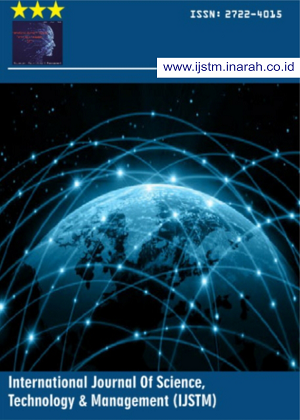Estimated Cost And Time For Completion Of The Bali GX Office And Co Working Project Using The Earned Value Method
Abstract
The GX Office & Co Working Bali construction project faced significant delays in the 27th week with a deviation of -4.31%, which could result in increased costs and delays in completion. So, an effective solution is needed to overcome project delays and ensure that the project is completed on time and within budget. This research aims to examine the application of the Earned Value Method (EVM) in evaluating the performance of the GX Office & Co Working Bali project by calculating the Estimated Temporary Schedule (ETS), Estimated All Schedule (EAS), Estimate Temporary Cost (ETC) and Estimate All Completion (EAC). The research uses descriptive quantitative methods by collecting data from weekly project progress reports, actual costs, and planned values. Data analysis was carried out by calculating Planned Value (PV), Earned Value (EV), Actual Cost (AC), Cost Performance Index (CPI), Schedule Performance Index (SPI), ETS, EAS, ETC, and EAC. The research results show an ETS value of 114 days with an EAS of 303 days. So, there is an additional time of 9 days from the planned schedule. ETC results amounted to IDR 3,723,631,710.12, with EAC amounting to IDR 7,699,818,710.12. So, the cost of completing the project is lower than planned, with a difference of IDR 2,545,727,760.88. The results of this research contribute to the project management literature by showing the effectiveness of EVM in identifying deviations and the basis for making strategic policies needed so that projects can be completed on time according to plan.
Downloads
References
J. Wirja, “Kajian Ergonomi dalam Desain Interior: Menciptakan Ruang yang Nyaman dan Fungsional,” WriteBox, vol. 1, no. 3, 2024.
M. R. Prayoga, A. Purnomo, and A. Saefudin, “Analisis dan Optimasi Pengelolaan Waktu Pengecoran Struktur Beton pada Proyek Konstruksi: Studi Kasus Keterlambatan Pengecoran Kolom, Balok, dan Plat,” J. Pendidik. Tambusai, vol. 8, no. 1, pp. 350–358, 2024.
Y. A. Messah, T. Widodo, and M. L. Adoe, “Kajian Penyebab Keterlambatan Pelaksanaan Proyek Konstuksi Gedung Di Kota Kupang,” J. Tek. Sipil, vol. 2, no. 2, pp. 157–168, 2013.
A. A. Taufan, N. Paryati, and E. Yulius, “Evaluasi Pelaksanaan Pekerjaan Proyek Rehabilitasi Gedung Dinas Kependudukan dan Catatan Sipil dan Bappeda Kota Bekasi,” BENTANG J. Teor. dan Terap. Bid. Rekayasa Sipil, vol. 6, no. 1, pp. 78–92, 2018.
A. Sugiyanto and O. Gondokusumo, “Perbandingan Metode Earned Value, Earned Schedule, Dan Kalman Filter Earned Value Untuk Prediksi Durasi Proyek,” JMTS J. Mitra Tek. Sipil, vol. 3, no. 1, p. 155, 2020, doi: 10.24912/jmts.v3i1.7069.
A. R. Hussein and S. F. Moradinia, “Mitigating Time and Cost Overruns in Construction Projects: A Questionnaire Study on Integrating Earned Value Management and Risk Management,” J. Stud. Sci. Eng., vol. 3, no. 2, pp. 37–51, 2023.
S. P. Riduwan, B. Witjaksana, and H. T. TJendani, “Cost Analysis On The Construction Of Sports Facilities In Kedewan Sub-District, Bojonegoro District With EVM (Earned Value Method),” Int. J. Adv. Technol. Eng. Inf. Syst., vol. 2, no. 4, pp. 347–365, 2023.
R. Aditama, “Analisis Biaya dan Waktu Menggunakan Metode EVM (Earned Value Method) Pada Proyek Konstruksi (Studi Kasus Pada Proyek Pembangunan Gedung Laundry RSUD Sidaorjo).” Universitas 17 Agustus 1945 Surabaya, 2021.
A. G. Saputra, W. Diantoro, M. Taufiq, and A. Khamid, “Pengendalian Biaya dan Waktu pada Proyek Pembangunan Factory 2 PT Hoga Reksa Garmen di Wilayah Garut (Studi Kasus pada Lantai 1 dan Mezanine),” Era Sains J. Penelit. Sains, Keteknikan dan Inform., vol. 1, no. 3, pp. 66–90, 2023.
G. M. Christy, V. H. Puspasari, and W. Nuswantoro, “Analisis Pengendalian Biaya dan Waktu Dengan Metode Nilai Hasil Pada Pembangunan Jalan Simpang Empat Gedung Baru Universitas Palangka Raya,” Bentang J. Teor. dan Terap. Bid. Rekayasa Sipil, vol. 11, no. 2, pp. 209–216, 2023, doi: 10.33558/bentang.v11i2.6944.
J. D. Leatemia, L. Leuhery, and N. Maelissa, “Penerapan Metode Nilai Hasil Pada Proyek Pembangunan Gedung Pelayanan Bpkb Dit Lantas Polda Maluku,” J. Agreg., vol. 1, no. 1, pp. 16–23, 2022.
A. Utami and A. Y. Ginting, “Penerapan Metode Earned Value Dalam Analisis Kinerja Biaya dan Waktu Proyek Konstruksi RSU. Vina Estetica,” J. Tek. Sipil, 2023, [Online]. Available: http://ejurnal.itats.ac.id/jts/article/view/5042.
A. Feriyanto, A. M. Hajji, and I. Alfianto, “Evaluasi Biaya dan Waktu pada Pembangunan Gedung Kantor Bupati Pasuruan Dengan Metode Earned Value,” Bentang J. Teor. dan Terap. Bid. Rekayasa Sipil, vol. 12, no. 1, pp. 97–110, 2024, doi: 10.33558/bentang.v12i1.7924.
F. Lamato, A. Utiarahman, and M. Y. Tuloli, “Analisis Earned Value Terhadap Proyek Pembangunan Renovasi Gedung Kantor Bpjn,” J. Vokasi Sains dan Teknol., vol. 1, no. 2, pp. 46–53, 2022, doi: 10.56190/jvst.v1i2.10.
H. L. Chen, W. T. Chen, and Y. L. Lin, “Earned value project management: Improving the predictive power of planned value,” Int. J. Proj. Manag., vol. 34, no. 1, pp. 22–29, 2016.
S.Tandi,A.Indartono,A.Nurvitasari, and D. Kurniawan,“Penerapan Metode Earned Value Analisis (EVA)Pada Proyek Reparasi Kapal,” in Proceedings Conference on Marine Engineering & its Application, 2023,vol. 6,no.1.
N. R. Adinda and D. Romadoni, “Analisis Kinerja Waktu Dan Biaya Proyek Rumah Deret Tamansari Menggunakan Metode Earned Value,” J. Online Sekol. Tinggi Teknol. Mandala, vol.17, no.1, pp. 63–74, 2022.
D. N. Anisa and A. B. Listyawan, “Analisa Pengendalian Proyek menggunakan Metode Earned Value pada Proyek Pembangunan Pondok Iqro,” in Prosiding Seminar Nasional Teknik Sipil UMS, 2023, pp. 618–623.
F. Nouban, N. Alijl, and M. Tawalbeh, “Integrated earned value analysis and their impact on project success,” Int. J. Adv. Eng. Sci. Appl., vol. 1, no. 1, pp. 34–39, 2020.
R. A. Prasetyo and G. J. Wibowo, “Pengendalian Biaya dan Waktu pada Proyek Bendungan Bener,” in Prosiding Seminar Nasional Teknik Sipil UMS, 2023, pp. 534–542.
S. U. Azizah, F. R. Yamali, and E. Handayani, “Analisa Nilai Hasil Terhadap Waktu pada Proyek Pembangunan Gedung Laboratorium FKIP Tahap IV(Lanjutan) Universitas Jambi,”J.Talent. Sipil,vol. 3,no 2,pp.95–103, 2020.
Copyright (c) 2024 International Journal of Science, Technology & Management

This work is licensed under a Creative Commons Attribution-ShareAlike 4.0 International License.





























